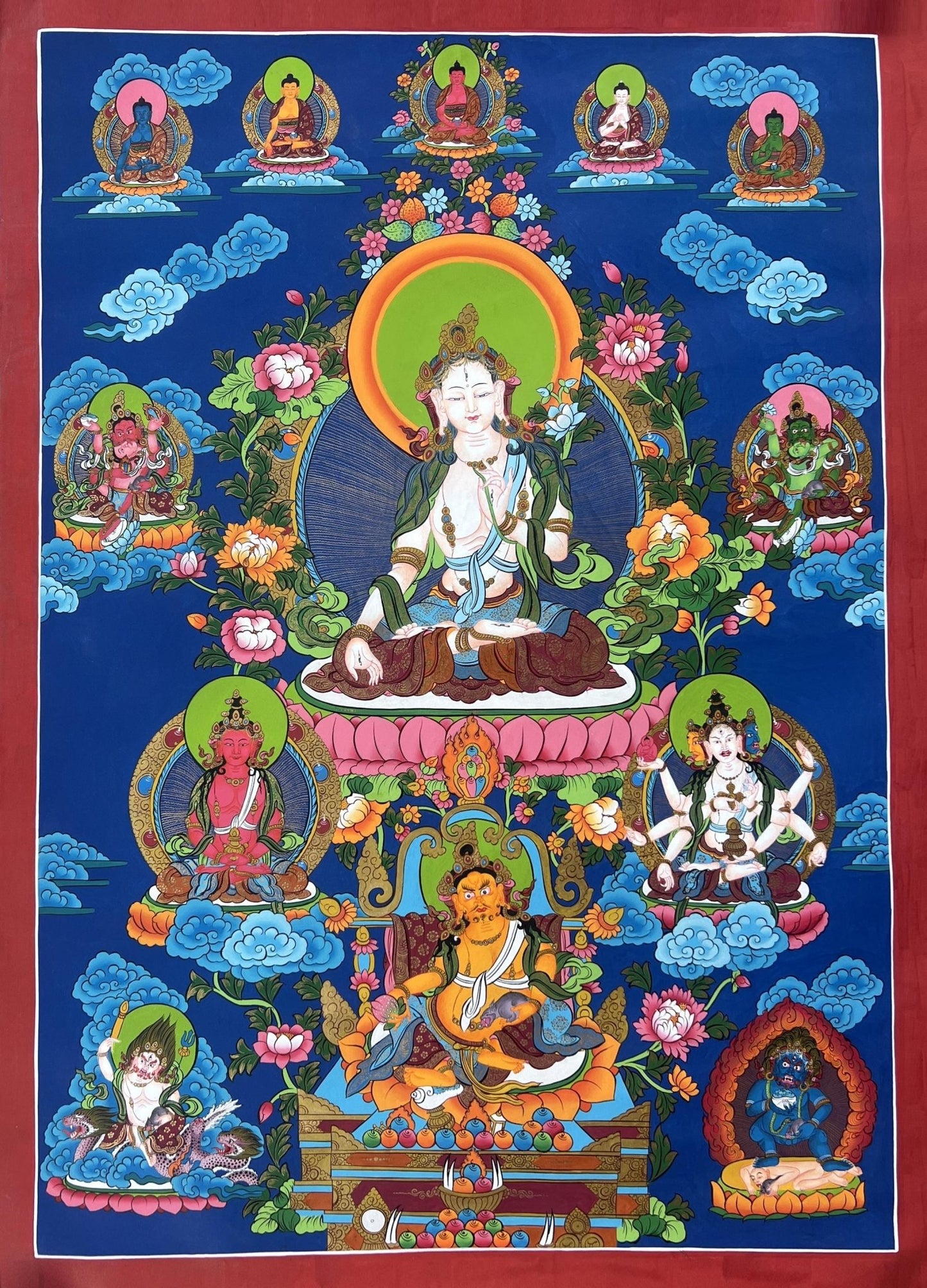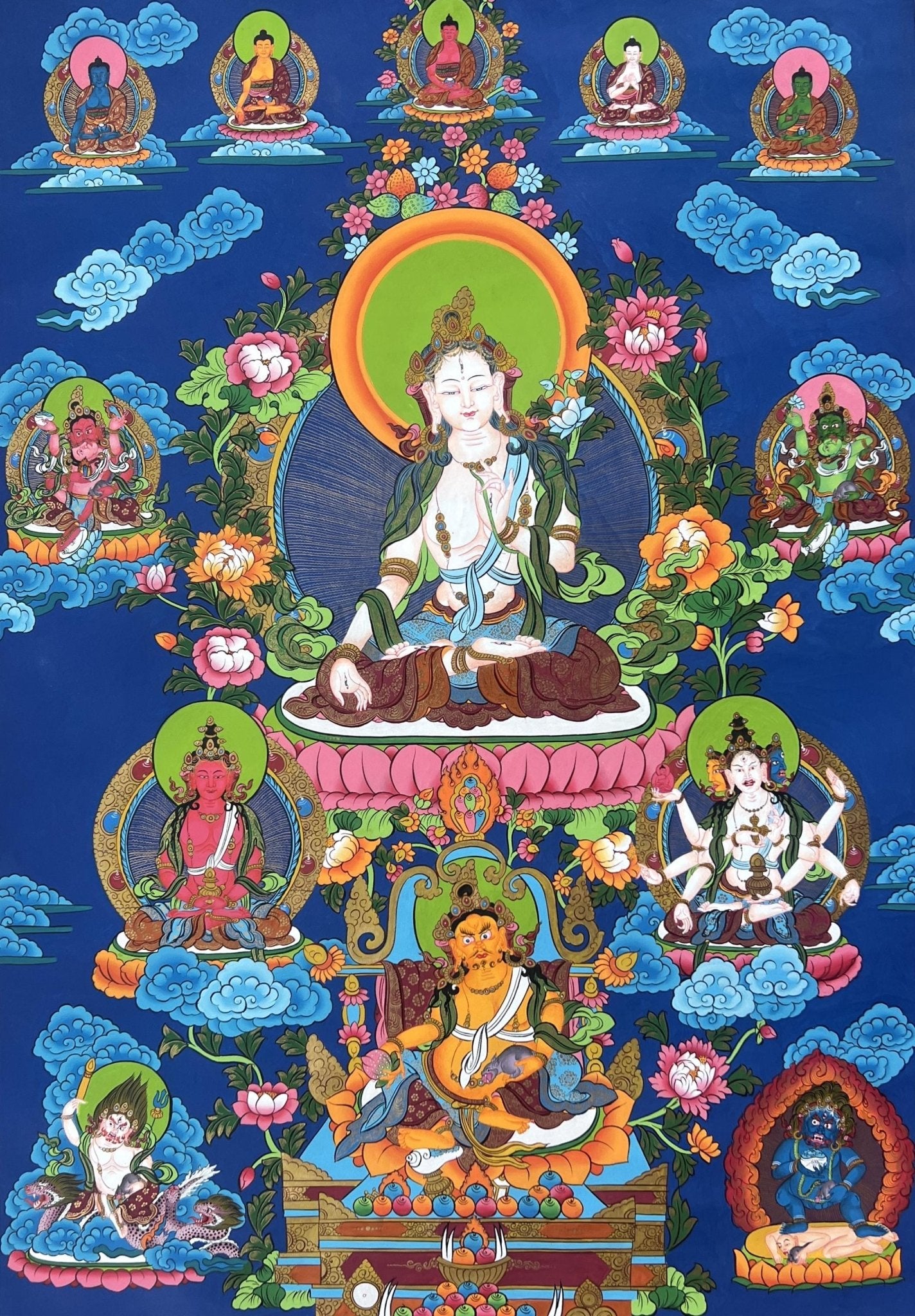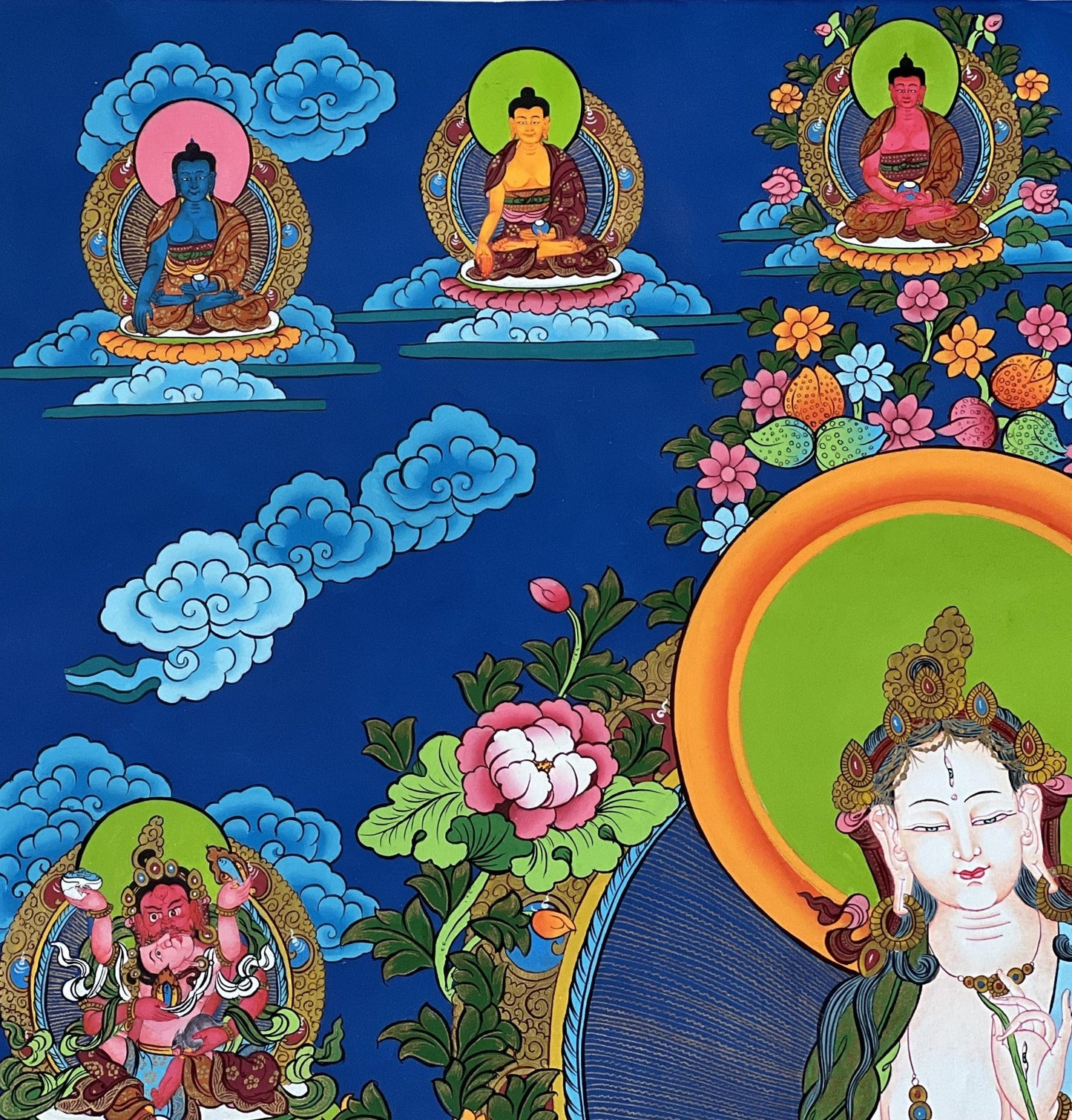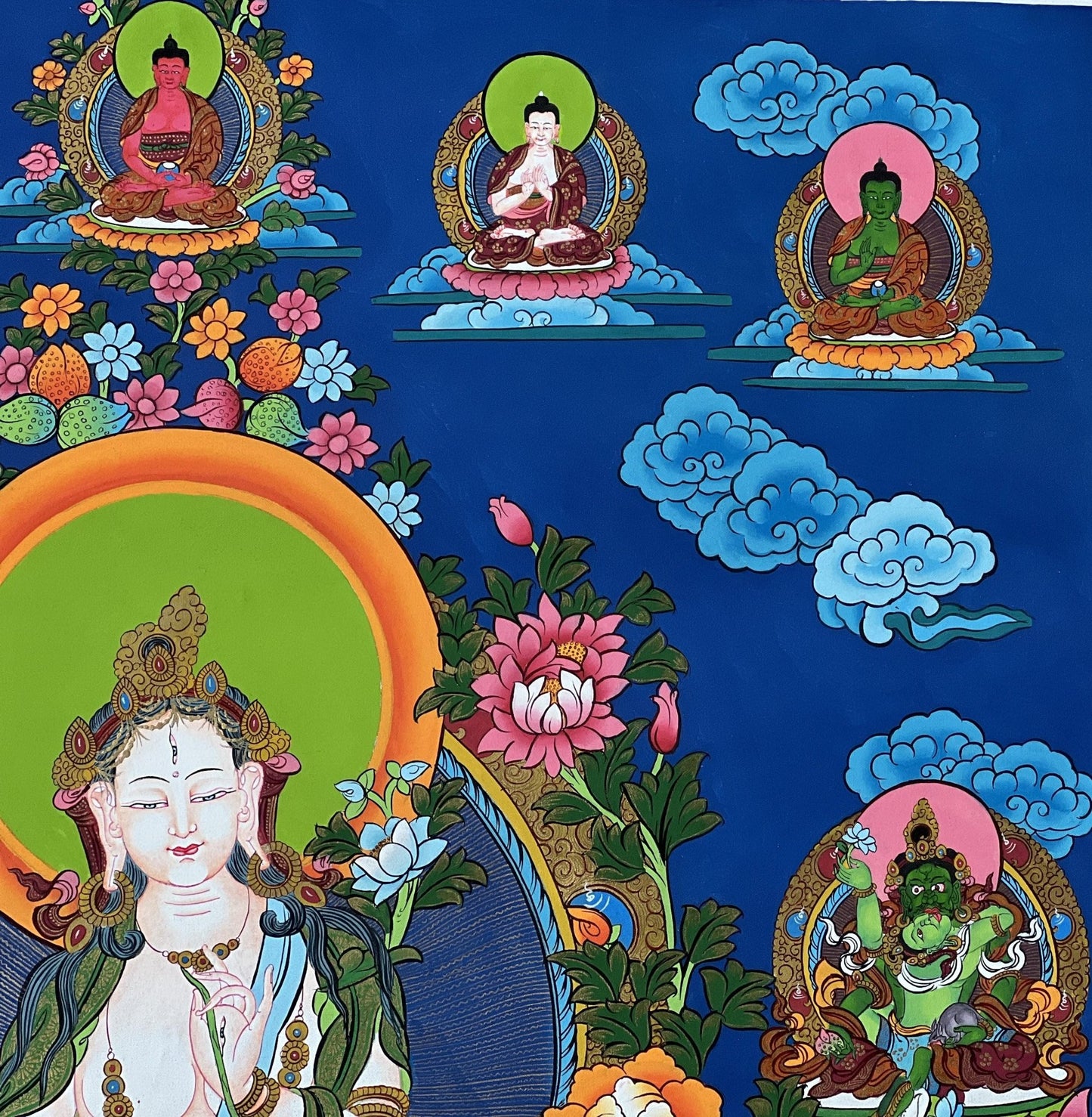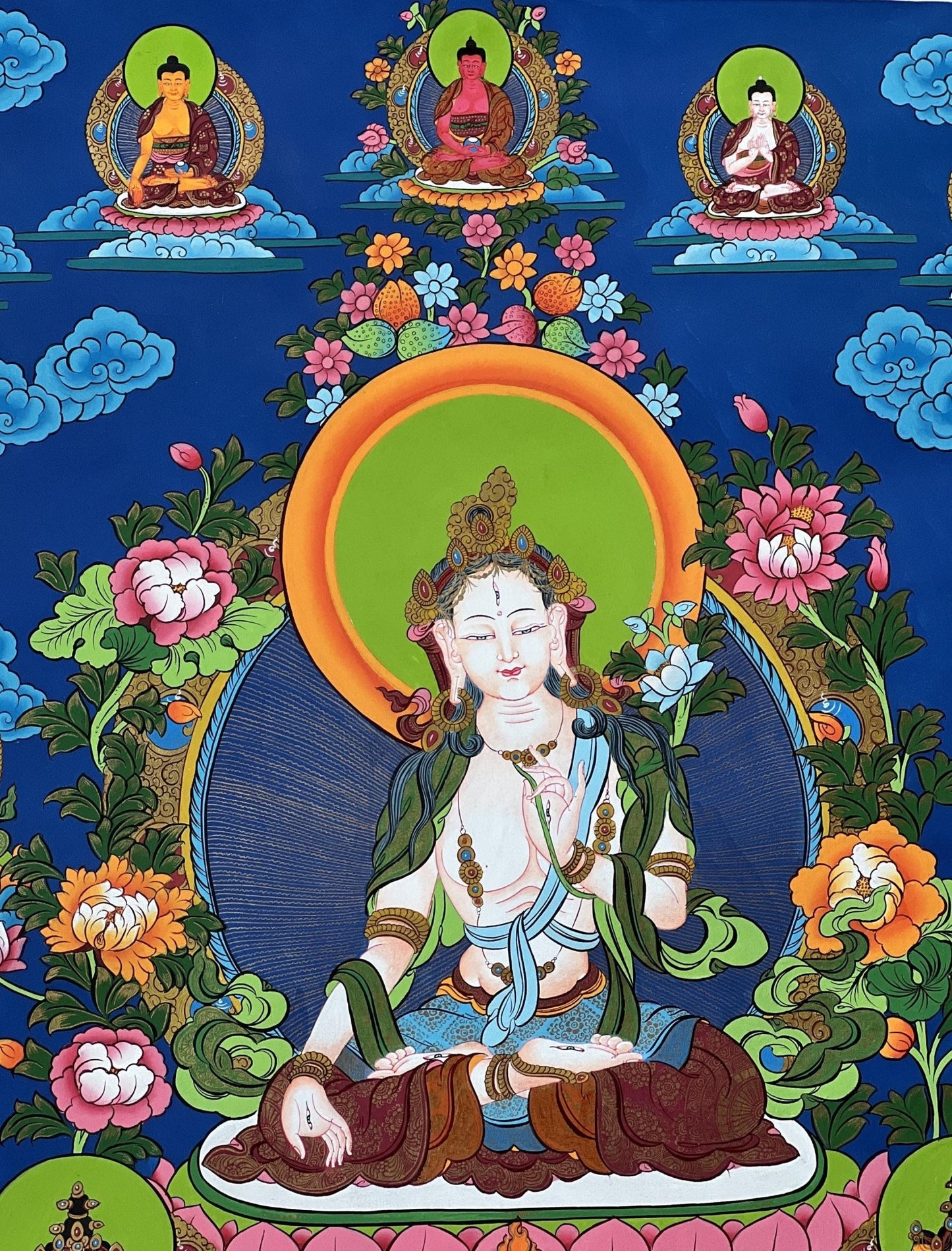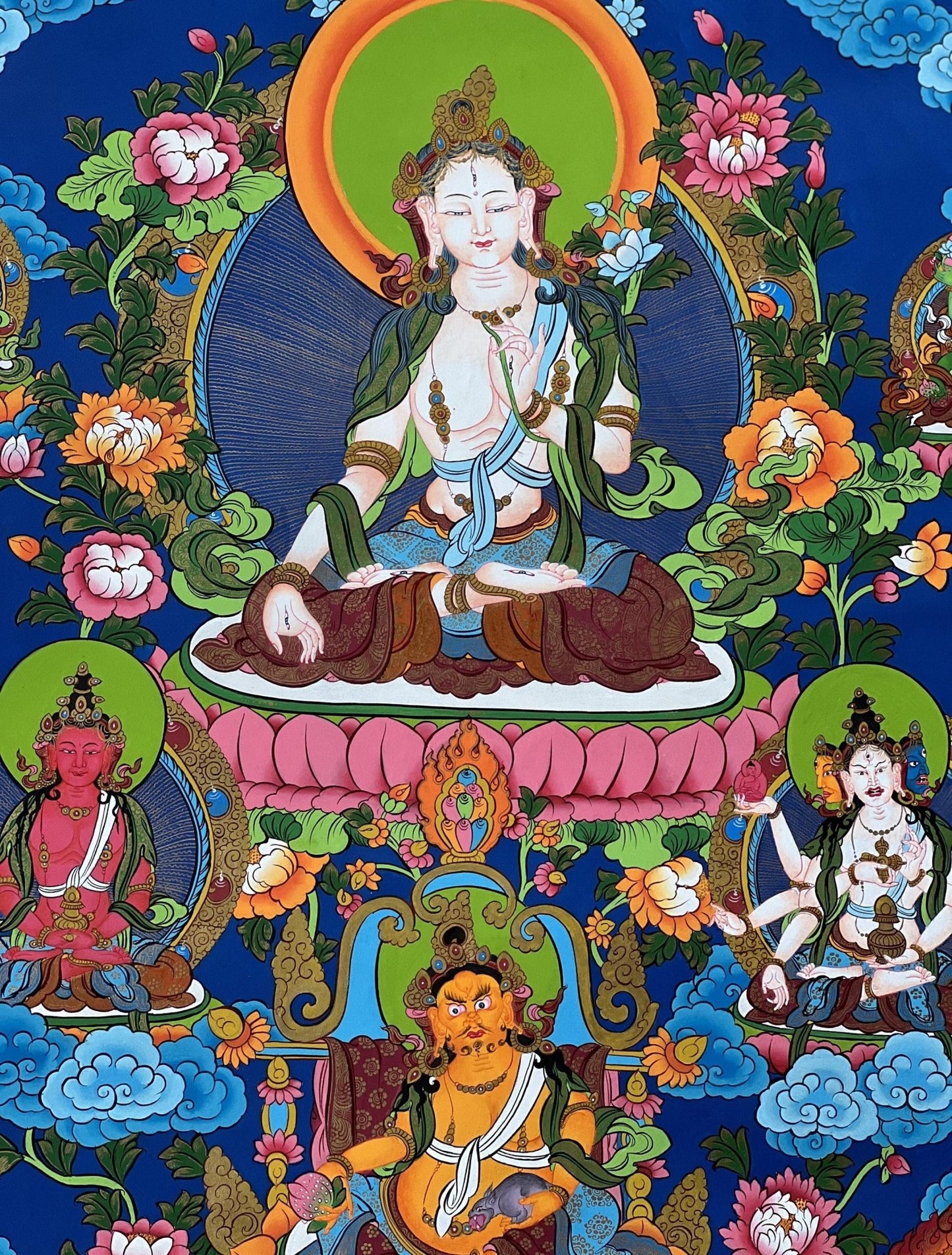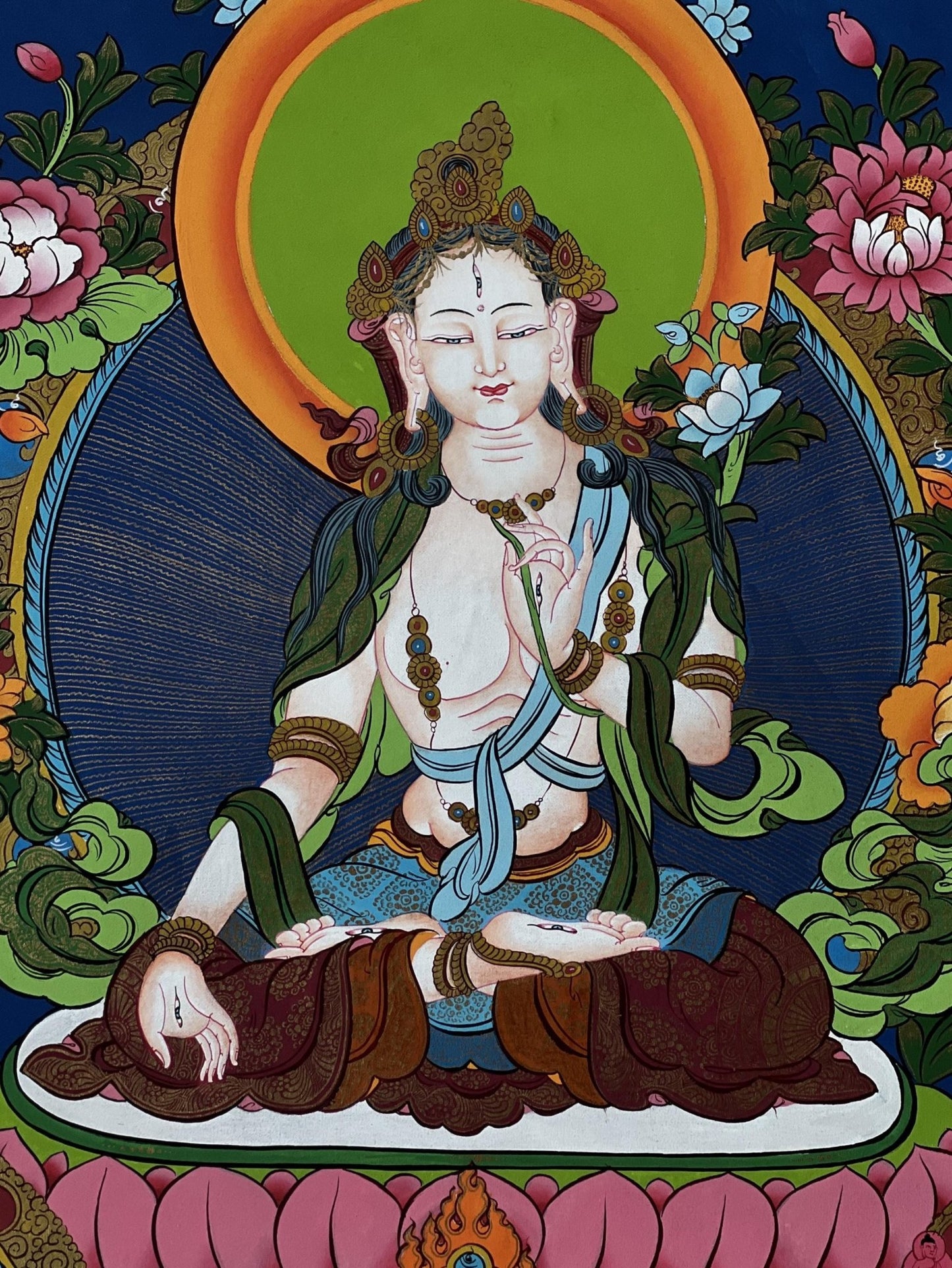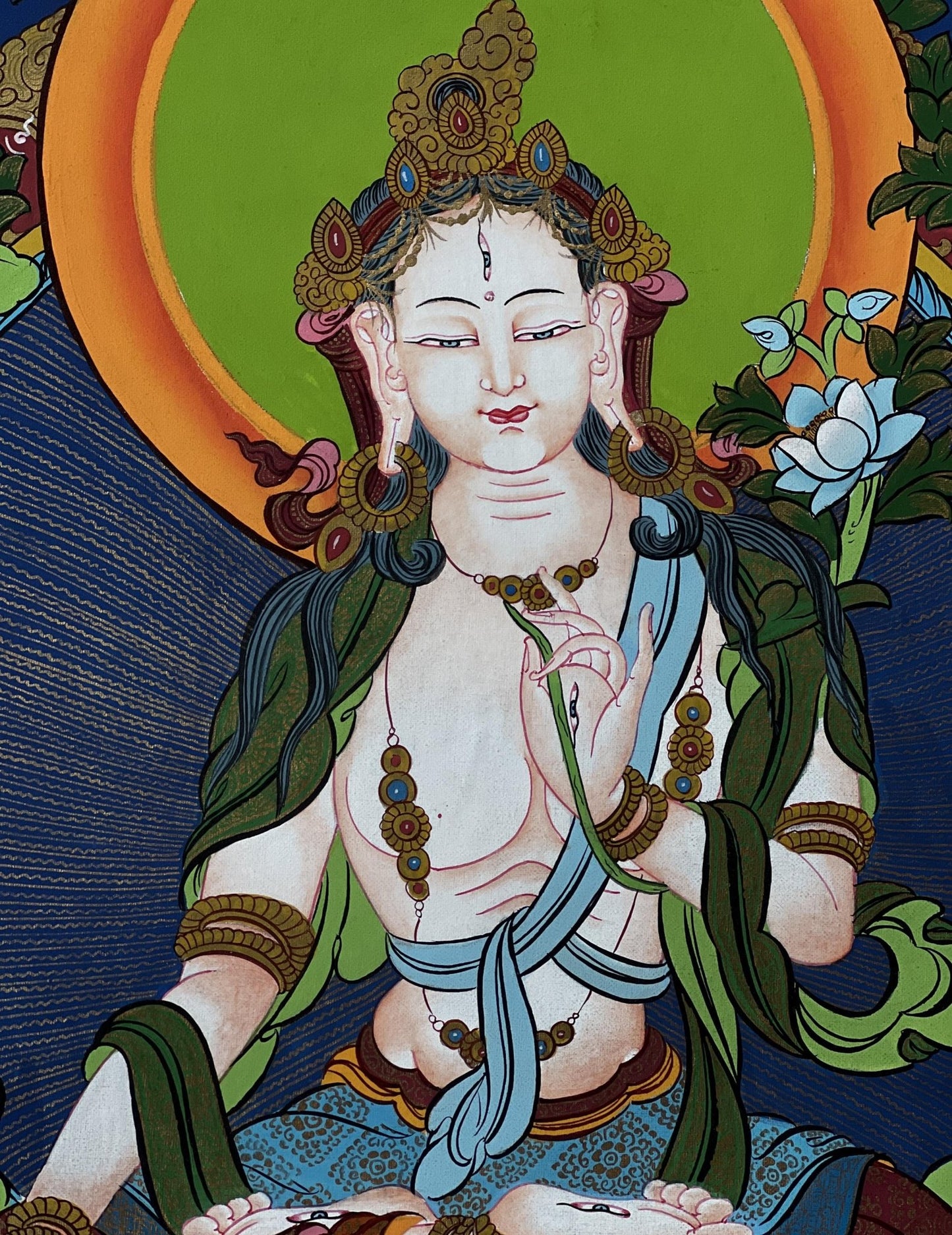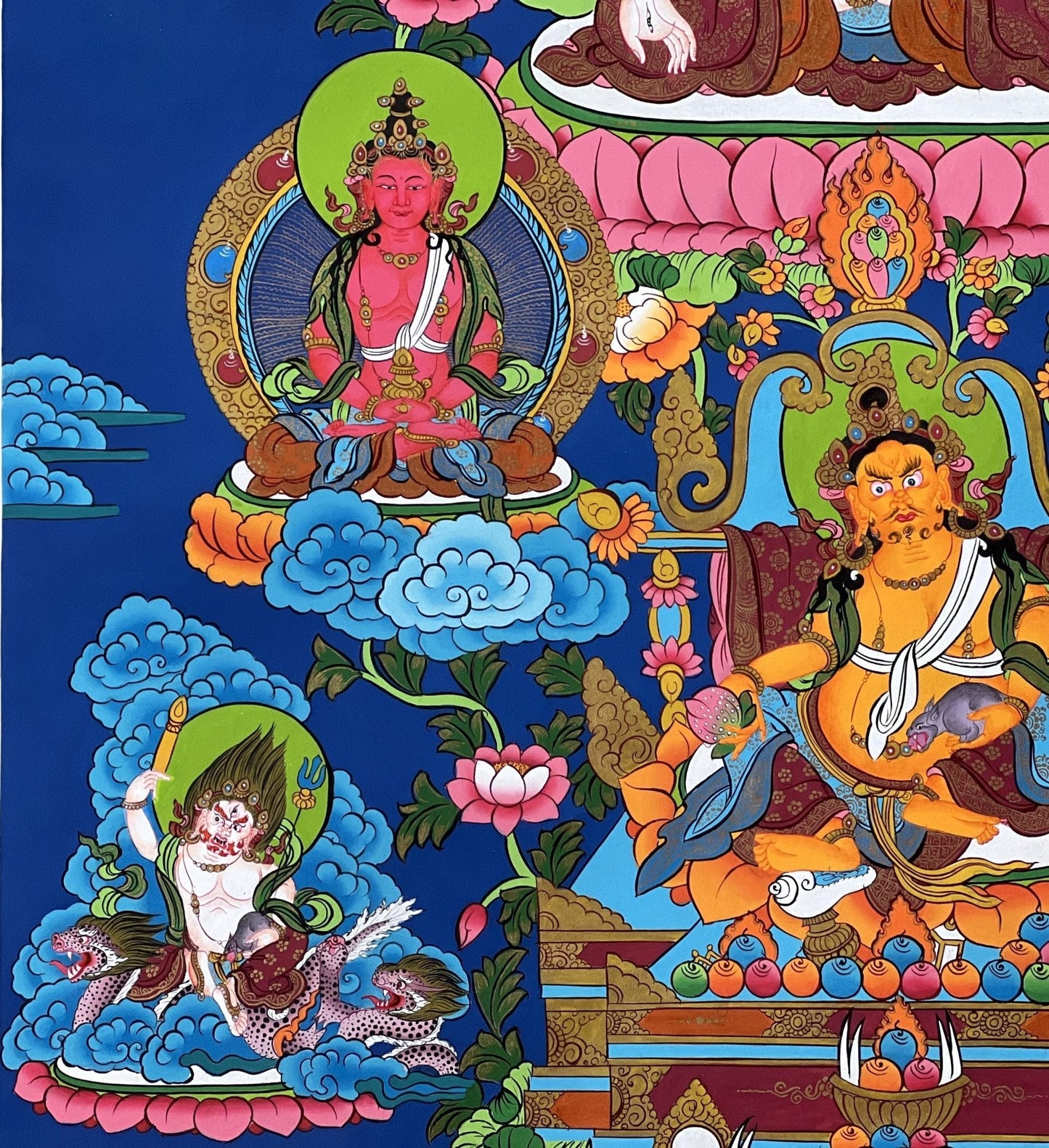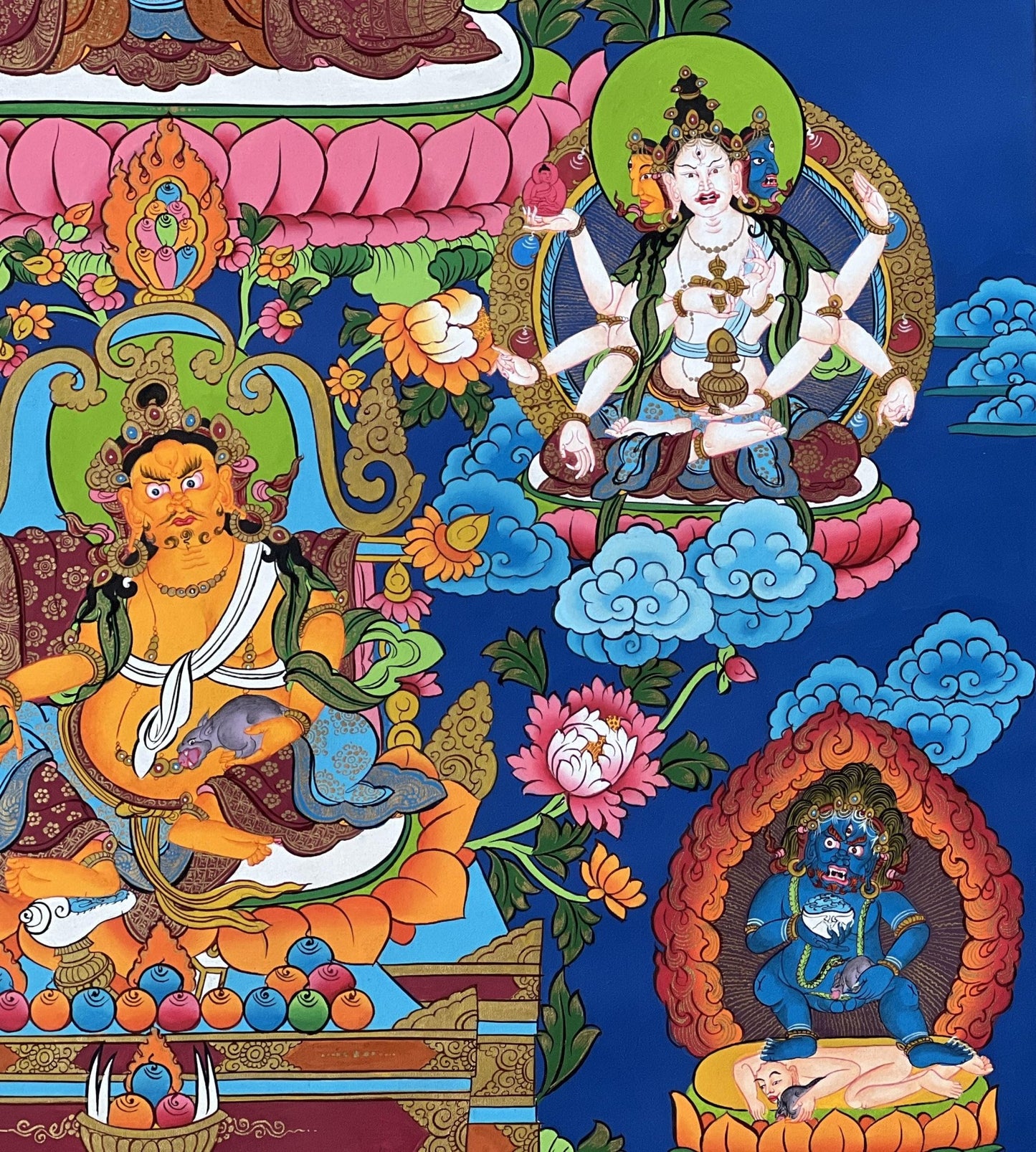1
/
de
10
Original Hand-painted Large White Tara / Mother Goddess Finest Masterpiece Tibetan Thanka / Thangka / Painting Compassion Meditation Art
Original Hand-painted Large White Tara / Mother Goddess Finest Masterpiece Tibetan Thanka / Thangka / Painting Compassion Meditation Art
Prix habituel
$1,797.99
Prix habituel
$0.00
Prix promotionnel
$1,797.99
Prix unitaire
/
par
Frais d'expédition calculés à l'étape de paiement.
Impossible de charger la disponibilité du service de retrait
This original hand-painted masterpiece is a Pancha (5) Buddha White Tara Tibetan Thangka Painting. White Tara is the mother goddess in Buddhism, and her compassion for living beings and her desire to save them from suffering are said to be even stronger than a mother's love for her children. As the personification of enlightened maternal compassion, she has infinite sympathy for those facing the challenges of worldly existence. She embodies the female aspect of the universe and is the source of all life, lovingly engendering, nourishing, and smiling at the vitality of creation. Meditation on the goddess grants health, long life, fearlessness, patience, and peace, and she is especially cherished for her swiftness in responding to the prayers of those who call upon her. Her white color symbolizes radiant purity, but it also expresses her fundamental nature, which is the ultimate Truth-complete and undifferentiated.
GESTURES AND ATTRIBUTES
White Tara is depicted in a posture of graceful contemplative ease, with both legs raised and crossed, displaying regal elegance and serenity. Her right hand is extended downward, palm open, with thumb and index finger touching. This hand position is known as Varada Mudra, the gesture of granting wishes and protection. Her left hand, raised to shoulder height with fingers extended and palm turned outward, is in the gesture of granting refuge and freeing from fears (Abhaya Mudra). Each of her hands also holds the stem of a beautiful lotus flower that floats above her shoulder, symbolizing her radiant purity and power. A distinctive characteristic of White Tara, represented here, is her seven eyes. She has the two usual eyes, plus one in the center of her forehead and one in her hands and feet. These eyes signify that she sees all the suffering and cries for help in the universe, symbolizing her divine omniscience.
The Pancha Buddha, or Five Dhyani Buddhas, surround this Thangka Painting at the top, with White Mahakala, Jambhala, and Vajrapani depicted at the bottom.
More about the Five Buddhas
The Five Dhyani Buddhas, commonly referred to as the Pancha Buddha, represent the five different qualities of Shakyamuni Buddha. The Pancha Buddhas are also known as the Five Wisdom Tathagatas and are widely revered in Vajrayana Buddhism. In Sanskrit, the Five Conquerors or Victors are prominent figures in the Vajrayana Buddhist tradition. Many Thangkas and collections of five Buddha statues in the residences of Buddhist practitioners are popular due to their representation of these five distinct qualities. The Pancha Buddhas include Vairochana, Akshobhaya, Amitabha, Ratnasambhava, and Amoghasiddhi.
These Five Buddhas represent five paradises in five different directions: Central, East, West, North, and South. In Nepali and Tibetan Buddhism, these Pancha Buddhas are represented in Buddha statues, images, paintings, Thangkas, and more. A collection of Nepali Buddha statues must include a set of five Pancha Buddhas, or it is considered incomplete, highlighting the significance of the Pancha Buddhas, especially in Nepalese and Tibetan Buddhism.
More About White Mahakala, Jambhala, and Vajrapani
Mahakala is known as the wish-granting deity and is very popular among the Gelugpa school of Tibetan Buddhism. His wealth aspect explicitly supports the comfort and economic well-being of tantric practitioners. The White Mahakala is generally worshiped to attain wealth.
Jambhala, also known as Dzambhala or Kubera, is the god of wealth whose blessings remove the obstacle of poverty, bringing wealth and abundance to virtuous Dharma practitioners. As it is difficult to attain spiritual realizations while afflicted by a lack of resources, Dzambhala generates prosperity, enabling practitioners to have the time, energy, and means necessary for accomplishment. According to the Sutras, while Shakyamuni Buddha was teaching one day, demons tried to disturb and confuse him. Dzambhala appeared before the Buddha to protect him. Recognizing Dzambhala's courageous action, the Buddha asked him if he would like to become a Dharma Protector to help all sentient beings. Dzambhala accepted the Buddha's offer, and since then, he has provided immediate assistance to all who call his name or chant his mantra. His blessings bestow good luck, increase virtues, prolong life, enhance intelligence, and provide both material and spiritual benefits.
Vajrapani is an important Bodhisattva who embodies the spiritual power of all the Buddhas. His name translates to "elder of the thunderbolt," and he protects those who follow the Mahayana path by removing all inner, outer, and hidden obstacles from their practice. Eons ago, Vajrapani was said to have been incarnated as one of Buddha Shakyamuni's primary disciples. He is often depicted alongside fellow disciples Manjushri (the embodiment of the Buddha's wisdom) and Avalokiteshvara (the embodiment of the Buddha's compassion). Together, these three Bodhisattvas represent the three aspects of Buddha-nature and the three necessary ingredients for enlightenment. Vajrapani symbolizes fierce determination and unwavering intent in the relentless struggle against negativity.
Size of Painting : 25-inch x 36-inch (63 cm x 91 cm)- Excluding Surrounding Border
Material: Handmade Cotton Canvas
Color: Tibetan Canvas Cotton, 24k Gold, Stone Powder Combination With Tibetan Hide Glue Mixture
Quality: Master
GESTURES AND ATTRIBUTES
White Tara is depicted in a posture of graceful contemplative ease, with both legs raised and crossed, displaying regal elegance and serenity. Her right hand is extended downward, palm open, with thumb and index finger touching. This hand position is known as Varada Mudra, the gesture of granting wishes and protection. Her left hand, raised to shoulder height with fingers extended and palm turned outward, is in the gesture of granting refuge and freeing from fears (Abhaya Mudra). Each of her hands also holds the stem of a beautiful lotus flower that floats above her shoulder, symbolizing her radiant purity and power. A distinctive characteristic of White Tara, represented here, is her seven eyes. She has the two usual eyes, plus one in the center of her forehead and one in her hands and feet. These eyes signify that she sees all the suffering and cries for help in the universe, symbolizing her divine omniscience.
The Pancha Buddha, or Five Dhyani Buddhas, surround this Thangka Painting at the top, with White Mahakala, Jambhala, and Vajrapani depicted at the bottom.
More about the Five Buddhas
The Five Dhyani Buddhas, commonly referred to as the Pancha Buddha, represent the five different qualities of Shakyamuni Buddha. The Pancha Buddhas are also known as the Five Wisdom Tathagatas and are widely revered in Vajrayana Buddhism. In Sanskrit, the Five Conquerors or Victors are prominent figures in the Vajrayana Buddhist tradition. Many Thangkas and collections of five Buddha statues in the residences of Buddhist practitioners are popular due to their representation of these five distinct qualities. The Pancha Buddhas include Vairochana, Akshobhaya, Amitabha, Ratnasambhava, and Amoghasiddhi.
These Five Buddhas represent five paradises in five different directions: Central, East, West, North, and South. In Nepali and Tibetan Buddhism, these Pancha Buddhas are represented in Buddha statues, images, paintings, Thangkas, and more. A collection of Nepali Buddha statues must include a set of five Pancha Buddhas, or it is considered incomplete, highlighting the significance of the Pancha Buddhas, especially in Nepalese and Tibetan Buddhism.
More About White Mahakala, Jambhala, and Vajrapani
Mahakala is known as the wish-granting deity and is very popular among the Gelugpa school of Tibetan Buddhism. His wealth aspect explicitly supports the comfort and economic well-being of tantric practitioners. The White Mahakala is generally worshiped to attain wealth.
Jambhala, also known as Dzambhala or Kubera, is the god of wealth whose blessings remove the obstacle of poverty, bringing wealth and abundance to virtuous Dharma practitioners. As it is difficult to attain spiritual realizations while afflicted by a lack of resources, Dzambhala generates prosperity, enabling practitioners to have the time, energy, and means necessary for accomplishment. According to the Sutras, while Shakyamuni Buddha was teaching one day, demons tried to disturb and confuse him. Dzambhala appeared before the Buddha to protect him. Recognizing Dzambhala's courageous action, the Buddha asked him if he would like to become a Dharma Protector to help all sentient beings. Dzambhala accepted the Buddha's offer, and since then, he has provided immediate assistance to all who call his name or chant his mantra. His blessings bestow good luck, increase virtues, prolong life, enhance intelligence, and provide both material and spiritual benefits.
Vajrapani is an important Bodhisattva who embodies the spiritual power of all the Buddhas. His name translates to "elder of the thunderbolt," and he protects those who follow the Mahayana path by removing all inner, outer, and hidden obstacles from their practice. Eons ago, Vajrapani was said to have been incarnated as one of Buddha Shakyamuni's primary disciples. He is often depicted alongside fellow disciples Manjushri (the embodiment of the Buddha's wisdom) and Avalokiteshvara (the embodiment of the Buddha's compassion). Together, these three Bodhisattvas represent the three aspects of Buddha-nature and the three necessary ingredients for enlightenment. Vajrapani symbolizes fierce determination and unwavering intent in the relentless struggle against negativity.
Size of Painting : 25-inch x 36-inch (63 cm x 91 cm)- Excluding Surrounding Border
Material: Handmade Cotton Canvas
Color: Tibetan Canvas Cotton, 24k Gold, Stone Powder Combination With Tibetan Hide Glue Mixture
Quality: Master
Partager
